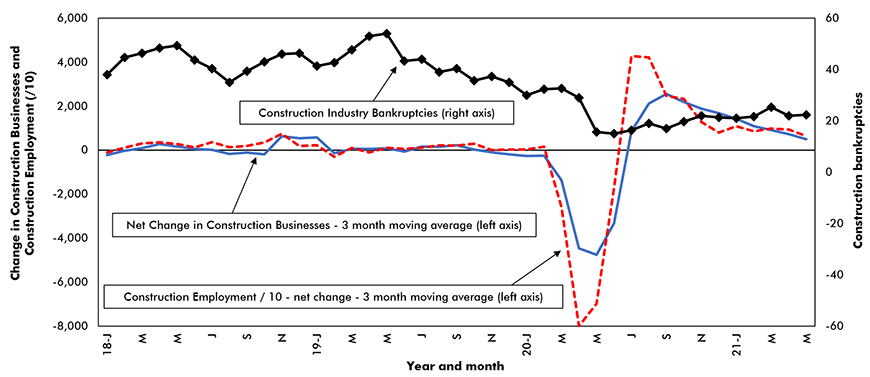The private sector bore the brunt of COVID-19’s first wave. Between February and May of 2020, the number of active businesses in Canada fell by -12.4%, putting 2 million private sector employees out of work. However, despite this sharp decline in the count of active enterprises, the number of companies that went bankrupt during the entire year retreated by -23%, to their lowest level in more than 30 years.
A possible explanation for the disconnect between the drop in active businesses and the unprecedented decline in bankruptcies is that a significant number of (mainly smaller) firms, most of which were in high-contact industrial fields such as accommodation and food services and retail trade, suspended operations until their prospects improved. In doing so they were attempting to avoid being handicapped by the stigma of bankruptcy.
COVID-19 hit construction hardest among goods-producing industries
While the first wave of COVID-19 hit high-contact service industries hardest, its impact on the construction industry was much more severe than on the other goods-producing industries (i.e., manufacturing, utilities, agriculture, or mining). In the first half of 2020, the number of active construction businesses dropped by -11.6 %, well ahead of the -7.3% decline posted by the other four major goods-producing industries.
Despite the sharp contraction in active construction businesses, bankruptcies in the industry fell by 48%, from 499 in 2019 to a 30-year low of 258 in 2020. Midway through 2020, the combination of low interest rates and government support programs helped construction firms maintain positive cash flows. Also of benefit were strong rebounds in both residential and non-res construction.
Construction start-ups rebound after first wave of COVID-19
From May 2020 to May 2021, the total number of active businesses exhibited a steady gradual increase with the number of ‘openings’ exceeding ‘closures’ by 87,700. A recent analysis by the Bank of Canada, titled COVID-19’s impact on the financial health of Canadian business: An initial assessment, highlights the factors which supported those businesses that remained open, plus provided a financial boost to new businesses. The low interest rate regime, which the Bank of Canada instituted (i.e., a record low 0.25% for the ‘overnight rate’) in late March 2020, is high on the list. In addition, the federal government introduced three programs including the Canada Emergency Business Account, the Canada Emergency Wage Subsidy, and the Canada Emergency Rent Subsidy aimed at helping businesses maintain positive cash flows.
Fuelled by very strong fiscal and monetary stimulus, plus strong pent-up demand and despite the onset of second and third waves of COVID-19, the number of active businesses in construction has increased by an all-industry leading 15,500 over the past 12 months.
Provinces which have seen particularly large increases in active businesses in the construction industry have been Ontario (+18.7%), Newfoundland and Labrador (+18.5%), Quebec (+14.4%), and British Columbia (+13.9%). Smaller year-to-date gains have occurred in Manitoba (+6.8%) and Alberta (+9.7%). Due to ongoing fiscal and monetary stimulus, construction bankruptcies are little changed from the same period in 2020.
Several construction indicators are flashing yellow
The Bank of Canada’s COVID-impact assessment states that, for all businesses, “the default risk appears broadly contained”. The BoC also notes that the major banks have started to reduce some of the loan loss provisions they boosted during the early stages of the pandemic.
However, there is evidence that the fundamental drivers of construction activity are losing some of the momentum they had at the beginning of this year. First, although housing demand is still strong, the volume of existing home sales has fallen by -28% over the past four months. Second, after hitting a record high of $11.1 billion in March, the total value of building permits has declined in three of the past four months due to a combination of slower growth of residential and non-residential building approvals. Third, although housing starts at 272,000 units are still elevated, they have trended lower since hitting a record high of 333,200 in March of this year.
Finally, after hitting a high of 3,020 in July of 2020, the net number of start-ups in construction has trended steadily lower since mid-2020. Consistent with this slowdown in business formations, year-over-year growth of employment in construction posted a gain of +3.5% in July of this year, down from a COVID-19 recovery gain of +23.8% in April.
Given the economy’s very weak second-quarter report card, it is highly unlikely the Bank of Canada will yank the proverbial “punch bowl” away by suddenly tightening monetary policy. However, as the incidence of COVID-19 infections retreats, the federal government (regardless of the party elected) will probably scale back the programs that have helped businesses in all industries. In our view, the combination of less fiscal stimulus and the above-mentioned evidence of a reduction in post-COVID-19 pent-up demand will cause a further slowing of construction start-ups and employment.
John Clinkard has over 35 years’ experience as an economist in international, national and regional research and analysis with leading financial institutions and media outlets in Canada.
Construction industry – new business formation, change in employment and bankruptcies

Chart: ConstructConnect – CanaData.
Please click on the following link to download the PDF version of this article:
Economic Snapshot Vol. 19, Issue 17 – Active business counts and bankruptcies in Canada’s construction sector – PDF


Recent Comments